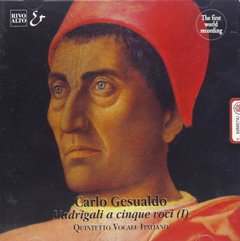Gesualdo da Venosa - Madrigali a 5 Voci Libro I (2012)
Gesualdo da Venosa - Madrigali a 5 Voci Libro I (2012)

[1] Baci soavi e cari [2] Madonna, io ben vorrei [3] Come esser puo [4] Gelo ha Madonna il seno [5] Mentre Madonna [6] Se da si nobil mano [7] Amor, pace non chero [8] Si gioioso mi fanno [9] O dolce mio martire [10] Tirsi morir volea [11] Mentre, mia stella, miri [12] Non mirar, non mirare [13] Questi leggiadri [14] Felice Primavera [15] Son si belle le Rose [16] Bella Angioletta Quintetto Vocale Italiano: Karla Schlean soprano Clara Foti mezzo-soprano Elena Mazzoni contralto Gastone Sarti baritone Dmitri Nabokov bass Angelo Ephrikian – director
Carlo Gesualdo, Prince of Venosa, murderer in 1590 of his guilty wife and her lover, later took a wife from the d’Este family, rulers of Ferrara, whose musical interests coincided with his own. He wrote a quantity of sacred and secular vocal music and a relatively small number of instrumental pieces. In style his music is unusual in its sudden changes of tonality, its harmony and its intensity of feeling, qualities that have found particular favour among some modern theorists.
Gesualdo, a nobleman of melancholy reserve, published six books of madrigals, the second of them originally under an improbable pseudonym. These include some remarkable and striking compositions, such as the five-voice Moro, lasso, al mio duolo, and the earlier Ahi, disperata vita. ---naxos.com
Gesualdo's reputation as a composer rests mainly on his five-voice madrigals, specifically those found in his fifth and sixth collections. This astonishingly adventurous music might seem like an historical aberration, but Gesualdo in fact began as a conservative composer, perfectly literate in the established vocabularies of Renaissance counterpoint. He developed his famous later style very gradually, quite deliberately and in parallel with other composers of his day. Anyone who wishes to hear the late works in their proper context needs to consider Gesualdo's first two collections of madrigals; the seeds of all that would come are found there.
Book 1 was published jointly with Book 2 in 1594, the year that Gesualdo married his second wife. The relatively conservative style of the madrigals afforded them a modest but sustained public success. Viewed against the harmonic background of his last works, Book 1 shows that Gesualdo was concerned with further developing the techniques of imitative polyphony. Instead of the subject motifs at the start of sections being neatly laid out without variation, Gesualdo tends to stagger the entrances quite closely, and almost never states the subject twice in exactly the same form. Everything is immediately in a state of change, with old forms of the material overlapping the new ones, until it's no longer quite clear, or important, which form was primary. It has the powerful, energistic simultaneity of a pun, and the sense of instability makes the music more tense and dramatic.
In Book 1, Gesualdo also shows mastery of difficult techniques like double counterpoint, in which two imitative strains are developed simultaneously. A lot of material gets rapidly passed between different voices, which can give the music a fabulously intricate surface. The passing around of material can also bring serious reconfigurations of the harmony, allowing for the exact same melodic lines to take on many different contrapuntal roles. It is a psychologically and technically sophisticated device that becomes poetic in the hands of first-rate composers.
One of Gesualdo's most idiosyncratic characteristics is his simultaneously sensitive and irreverent treatment of texts. In Book 1 this is already fully in effect. Even if he showed deep sensitivity to the mood of the poems, as well as an uncanny talent for drawing out different emotional readings of the same textual moments, he made absolutely no attempt to maintain the structural integrity of the poems. He applies his cutting, pasting, and shaping process to however he wishes, working and reworking, smashing and overlapping. The result, if read start to finish, is a strange collage of the original. The journey Gesualdo will take from here to Book 5 is a long one, but the destination was distantly visible from the very first step. If it seems clownish in its day-glo artificiality, the music of Book 1 should at least remind us that the hyper-emotionalism of the later books is mainly a stylistic affectation, even if its irresistible force of rhetoric makes it seem sincere. --Donato Mancini, Rovi
download (mp3 @320 kbs):
uploaded yandex 4shared mega mediafire solidfiles zalivalka cloudmailru oboom
Zmieniony (Wtorek, 03 Marzec 2015 16:36)








